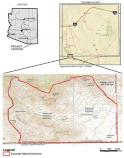Get PDF
Download PDF of this article
Abstract and key words
Abstract: To protect a lesser long-nosed bat post-maternity roost, the National Park Service installed bat-compatible gates on the entrances to the abandoned State of Texas Mine within Coronado National Memorial in southeastern Arizona. Video camcorder surveys performed during peak occupation of this roost examined colony size, gate-induced injury or mortality, and bat exit rates. Although the colony decreased in size after the installation of the gate, the reduced number of bats cannot with certainty be attributed to the presence of the gate. A large wildfire and drought likely contributed to reduced numbers. The study did not find evidence that the gates caused injury or mortality, or impeded the bats while exiting the roost. Further monitoring could ensure that lesser long-nosed bats continue to use the State of Texas Mine.
Key Words: Arizona Game and Fish Department, bat-compatible gates, bat emergence rates, bat migration, bat roosts, Coronado National Memorial, endangered bats, endangered species, Huachuca Mountains, Leptonycteris yerbabuenae, lesser long-nosed bats, State of Texas Mine, U.S. Fish and Wildlife Service, video camcorder survey
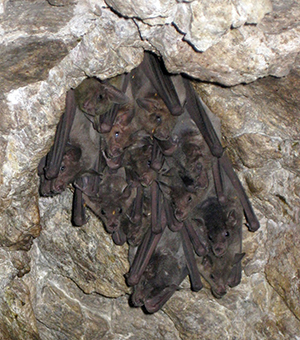
Gabrielle Diamond
CORONADO NATIONAL MEMORIAL IS WITHIN THE HUACHUCA MOUNTAINS in southeastern Arizona on the U.S.-Mexico border (fig. 1; see photo gallery at top of page). There are numerous abandoned mines within the memorial, including adits and shafts that are used by bats as roosting sites. (See related article on abandoned mineral lands.) One such abandoned mine is the State of Texas Mine, which was active from 1897 until 1947 producing primarily copper but also some zinc, lead, silver, and gold (Mindat.org and the Hudson Institute of Mineralogy 2015). The mine is used as a roost from July to October by lesser long-nosed bats (Leptonycteris curasoae yerbabuenae) (fig. 2, right). This bat species is migratory (between Central Mexico and southern Arizona) and nectarivorous (feeds on nectar), and was listed as endangered by the U.S. Fish and Wildlife Service (USFWS) in 1988 (53 FR 38456).
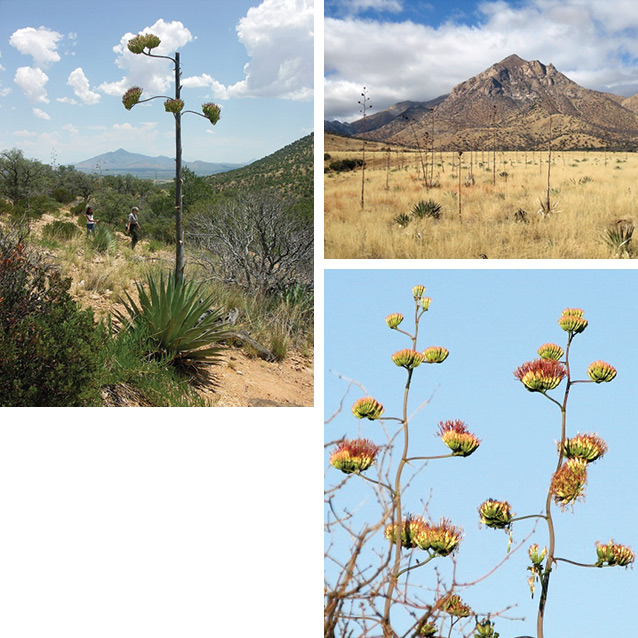
Figure 3. (Top left) Palmer’s agave with a flowering stalk pictured at Coronado National Memorial. (Top right) A stand of Palmer’s agave at Coronado. (Bottom right) Palmer’s agave with a flowering panicle.
Lesser long-nosed bats travel approximately 1,500 miles (2,414 km) yearly to reproduce in maternity colonies in northern Mexico and southwestern Arizona (Ceballos et al. 1997; Rojas-Martinez et al. 1999). These bats feed on plants within the families Cactaceae and Agavaceae (Cockrum and Petryszyn 1991; Fleming et al. 1998; Stoner et al. 2003) and follow seasonal flowering and fruiting patterns (Wilkinson and Fleming 1996; Ceballos et al. 1997; Rojas-Martinez et al. 1999). As a consequence of this tie to seasonal flowering cycles, lesser long-nosed bats typically arrive in northern Mexico and southwestern Arizona in early summer (Ceballos et al. 1997; Rojas-Martinez et al. 1999). During the early part of their stay in Arizona (late April to late July), pregnant females congregate at traditional roost sites, give birth, and raise their young at lower elevations within the range of columnar cacti. By late July, most females and young have dispersed from the maternity colonies and some have moved to higher elevations in southern Arizona, shifting their diet to the nectar of flowering paniculate agaves (those with loose, irregular flower clusters), including Palmer’s agave (Agave palmeri) (fig. 3, above). During late summer these bats roost at post-maternity sites like the State of Texas Mine.
Lesser long-nosed bats were first detected roosting in the State of Texas Mine in 1993, five years after the mine’s entrances had been secured with aircraft cable nets to prevent people from entering. Unfortunately, the cable nets at the State of Texas Mine were easily breached. Lesser long-nosed bats are highly susceptible to roost disturbance by humans, and high human activity generally leads to the complete abandonment of roosts. Coronado National Memorial has a high volume of illegal immigration and drug trafficking because of its proximity to the U.S.-Mexico border; areas historically used by these migrants and traffickers include the State of Texas Mine. Thus, it became necessary to protect the public and this bat roost with a more robust closure.

Gabrielle Diamond (3)
In order to protect lesser long-nosed bats roosting in the State of Texas Mine, the National Park Service closed all three entrances to the roost with bat-compatible steel gates (fig. 4, above). The three entrances include the main portal (fig. 4, at left), equipped with a large custom-fit cupola in 2010; a smaller side opening just west of the main portal that was equipped with a steel cupola in 1997 (middle photo at left); and a lower opening just southeast of the main portal equipped with a standard bat gate in 2010 (fig. 4, at right). While these gates mitigated the threat of human disturbance to roosting lesser long-nosed bats and used bat-accessible designs, their impact on bat behavior and overall colony size needed to be evaluated.
Study objectives
Coronado National Memorial consulted with the U.S. Fish and Wildlife Service prior to construction of the main cupola at the State of Texas Mine regarding potential impacts on the endangered bats. The National Park Service contracted Westland Resources, Inc., and the Arizona Game and Fish Department Wildlife Contracts Branch to design a study to monitor the bats’ use of the State of Texas Mine. The study would examine colony size, gate-induced injury or mortality, and bat exit rates. Surveys to quantify emergence counts and exit rates were conducted at the mine from 2010 to 2013 to assist the National Park Service and the U.S. Fish and Wildlife Service in determining how the bats’ use of the newly constructed cupola compared with their use of the cable net closure. The cable net closure condition is this study’s baseline condition as determined by the USFWS (2010), meaning it is the basis for determining the potential impacts of the newly constructed cupola.
Methods
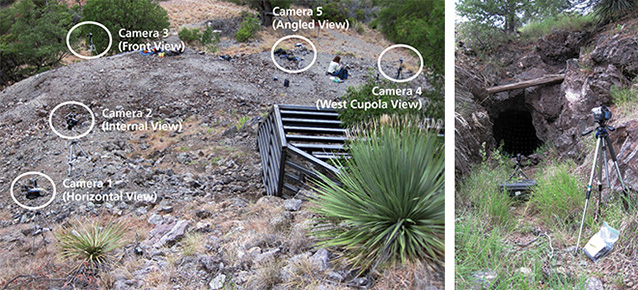
Gabrielle Diamond (2)
External video surveys were conducted to monitor lesser long-nosed bat activity at all State of Texas Mine openings using six video camcorders equipped with infrared (IR) capabilities and multiple IR light sources to further illuminate the observation area. Surveyors used IR light sources rather than conventional sources to minimize disturbance to bats and to decrease the likelihood that the lights would induce modifications in the bats’ behavior. Video recordings enhance the accuracy of the counts, allow for the calculation of observer/analyst error, and provide a permanent monitoring record. Four cameras set around the main steel gate recorded bat movement through each of the seven gate panels (fig. 5). A fifth camera focused on the west side cupola and a sixth focused on the lower adit. General lighting and video camera placement remained the same throughout the study. Minor enhancements and modifications were made to the layout as needed.
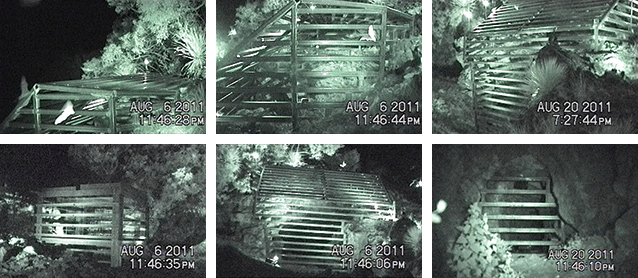
Still images by Gabrielle Diamond, collected from video
To review and analyze the videotapes of bat activity collected during the external surveys at the State of Texas Mine, original taped video data were transferred to hard drives for analysis using digital video (DV) format. The analysis was conducted on a personal computer using the DV file and professional video viewing and editing software. This software allows analysis of a video in slow motion, repeated examination of particular video segments, and the capture of individual frames to JPEG or similar formats. The videos were observed at slower speeds in order to be able to count the number of bats exiting per minute. Sections of the videos were analyzed at quarter, half, or full speed, depending on the amount of bat activity (fig. 6).
Video analysts quantified bat activity per minute at all three openings of the State of Texas Mine during each survey. Since bats have a tendency to exit then reenter mine and cave entrances several times before their final emergence, individual bats were counted exiting the gate (“outs”) and entering the gate (“ins”) through each of the seven panels that make up the main cupola. The counts for each panel were summed by minute to estimate the total number of bats. Bats per minute and net bats per minute (outs minus ins) were calculated to get a count of the number of bats that emerged from the mine.
To inform the potential effect of the gate on the number of bats exiting per minute (exit rate), this study used survey data from 2003 to 2006 when the cable net was in place on the main entrance to the mine (baseline), survey data provided by the Arizona Game and Fish Department from 2008 when partial and full test gates were used on the main entrance, and survey data collected during this study from 2010 to 2013 for the main cupola. Differences in peak exit rate (the highest observed number of bats exiting per minute), standardized emergence duration (the average number of minutes it took for 1,000 bats to exit), and total number of bats (the colony size or count) were tested using separate generalized linear models. These three variables were considered dependent variables, and the closure type (cable net, partial test gate, full test gate, and cupola) the independent variable. Peak exit rate and standardized emergence duration were natural-log transformed to satisfy normality assumptions of generalized linear models.
We observed a strong correlation between colony size and the rate at which the bats exited the roost: the more bats that were in the roost, the faster they exited per minute and the shorter the duration for the entire colony to exit. The effect of colony size on the bats’ behavior was removed from the analysis by calculating the time taken for 25, 50, 75, and 100 percent of the bats to emerge from the roost. This approach produced four variables that were not correlated with the total number of bats and that could provide information on the effects of the gate on exit rates without the confounding influence of the total number of bats. We used Welch’s correction to control for unequal variance among closure types and the Tukey method to account for the increased probability of finding statistically significant results because of multiple pairwise comparisons among closure types. Differences between closure types were considered statistically significant at P < 0.05.
Study findings
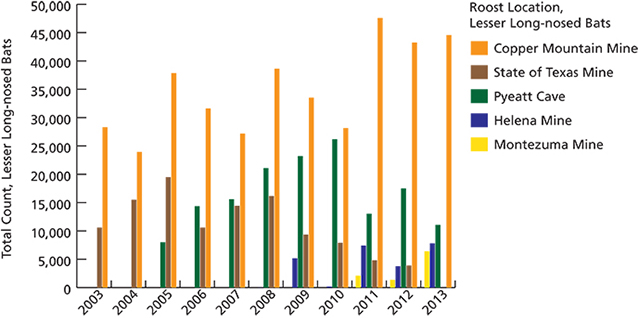
See photo gallery at top of article for the sources for data in this this figure
Finding 1: Colony size decreased after the cupola was installed and continued to decline during the study, but this decline cannot be attributed to the prescence of the cupola with certainty
The study compared the State of Texas Mine colony size to regional lesser long-nosed bat population trends using general comparisons of observed peak colony size at the State of Texas Mine (a post-maternity roost) with other roosts in southern Arizona. For more than a decade routine counts of lesser long-nosed bat roosts have been conducted simultaneously in mid-August throughout the bats’ range in southern Arizona, and the data were compiled by the Arizona Game and Fish Department. Simultaneous counts evaluate regional lesser long-nosed bat trends through direct comparisons of lesser long-nosed bat numbers during the same year. However, the usefulness of roost count data at other sites is limited because no standardized methodology for conducting lesser long-nosed bat roost counts is applied across the species’ range. In addition, many variables can affect population trends of this species within its entire range, such as changes in forage availability, drought, and other habitat changes such as wildfires.
Observed peak colony counts at the State of Texas Mine have fluctuated since 2003; its highest count of roughly 19,500 lesser long-nosed bats occurred in 2005 (Wolf and Dalton 2009). During our monitoring period of 2010 to 2013, the observed peak colony size at the State of Texas Mine decreased from a high of approximately 7,900 lesser long-nosed bats in 2010 to 4,800 in 2011, 3,900 in 2012, and 3,500 in 2013.
Comparisons of observed peak colony counts at the State of Texas Mine with those at four other roosts in southeastern Arizona (Copper Mountain Mine, a maternity roost, and Pyeatt Cave, Helena Mine, and Montezuma Mine, post-maternity roosts) show no consistent patterns between years (fig. 7, above). However, a closer look at counts from roosts at Copper Mountain Mine, Pyeatt Cave, and Helena Mine shows how lesser long-nosed bat colony counts can fluctuate between roosts (table 1).
| Table 1. Observed peak colony size change (increasing or decreasing) at four lesser long-nosed bat roosts based on counts conducted from 2004 to 2013 | ||||
|---|---|---|---|---|
| Year | State of Texas Mine (Post-maternity) |
Copper Mountain Mine (Maternity) |
Pyeatt Cave (Post-maternity) |
Helena Mine (Post-maternity) |
| 2004 |  a a(+4,900)d |
 (−4,400) |
No data | No data |
| 2005 |  (+4,000)d |
 a a(+13,900) |
No data | No data |
| 2006 |  (−8,900)d |
 (+6,300) |
 (+6,400) |
No data |
| 2007 |  (+3,800)d (+3,800)d |
 (−4,400) (−4,400) |
 (+1,200) (+1,200) |
No data |
| 2008 |  (+1,700)e |
 (+11,400) |
 (+5,500) |
No data |
| 2009 |  (−6,800)f |
 (−5,100) |
 (+2,100) |
 (+5,100) |
| 2010 |  (−1,400)g |
 (−5,400) |
 (+3,000) |
 b b(−5,000) |
| 2011 |  (−3,000)c,g |
 (+7,600) |
 (−13,200)c |
 (+7,300) |
| 2012 |  (−900)g* |
 (−4,300) |
 (+4,500) |
 (−3,600) |
| 2013 |  (−400)g* |
 (+1,300) |
 (−6,400) |
 (+4,000) |
Notes: Up arrow ( ) represents an increase in lesser long-nosed bat counts from one year to the next while a down arrow ( ) represents an increase in lesser long-nosed bat counts from one year to the next while a down arrow ( ) denotes a decrease. The magnitude of change is represented by the difference in the number of lesser long-nosed bats between years and is rounded to the nearest hundred. Gating began at the State of Texas Mine in 2008 with a partial PVC test gate; a full PVC test gate was implemented and remained in place in 2009. The permanent full square-tube steel gate was installed on the main portal at the State of Texas Mine in 2010. The Copper Mountain Mine, Pyeatt Cave, and Helena Mine roosts were not gated during this period. ) denotes a decrease. The magnitude of change is represented by the difference in the number of lesser long-nosed bats between years and is rounded to the nearest hundred. Gating began at the State of Texas Mine in 2008 with a partial PVC test gate; a full PVC test gate was implemented and remained in place in 2009. The permanent full square-tube steel gate was installed on the main portal at the State of Texas Mine in 2010. The Copper Mountain Mine, Pyeatt Cave, and Helena Mine roosts were not gated during this period.The accuracy estimates of the colony counts and the exact methodologies used to obtain the counts outside of this study are unknown. *In 2012 the observed peak in colony size occurred during on 1 September during the last survey of the season. The third survey in 2013 was canceled because of a law enforcement emergency at the memorial, and the observed peak in colony size was on 17 August during the last survey of the season. In 2010 and 2011 we observed a decline in colony size during our last survey of the season, and in 2012 and 2013 we did not observe this decline. Some level of uncertainty always exists because surveys may not be conducted during the actual peak in colony size and observed colony size may not reflect its actual size. aThe actual count at the Copper Mountain Mine in 2003 was 28,310; in 2004 it was 23,945 (Tibbitts 2010). bRain event prevented complete survey. cThe Monument Fire occurred in the Huachuca Mountains in mid-June 2011. The fire burned in the immediate vicinity of the State of Texas Mine and in the vicinity of Pyeatt Cave. dCable net closure installed on the State of Texas Mine main opening. ePartial PVC test gate installed on the State of Texas Mine main opening. fFull PVC test gate installed on the State of Texas Mine main opening. gCupola gate installed on the State of Texas Mine main opening. |
||||
The Monument Fire, a 30,526-acre (12,353 ha) wildfire on the Coronado National Memorial in mid-June 2011 (AZEIN 2011), burned areas immediately adjacent to the State of Texas Mine. Although this fire occurred before lesser long-nosed bats had been observed in the region that year, it is likely one of the causes for the reduction in lesser long-nosed bats at the State of Texas Mine and Pyeatt Cave (also located in the Huachuca Mountains within the Monument Fire burn area) in 2011, because of the fire’s impact on the bats’ foraging resources in the region.
Finding 2: The cupola did not appear to cause any bat injury or mortality.
The study next focused on bat movement, mortality, and injury. Bats were able to exit through the gate during each survey, and there were no observations of bats injured or killed by direct contact with the gate. The low number of dead bats observed during this study (four bats in four years) should not trigger concern and is likely the result of normal background mortality.
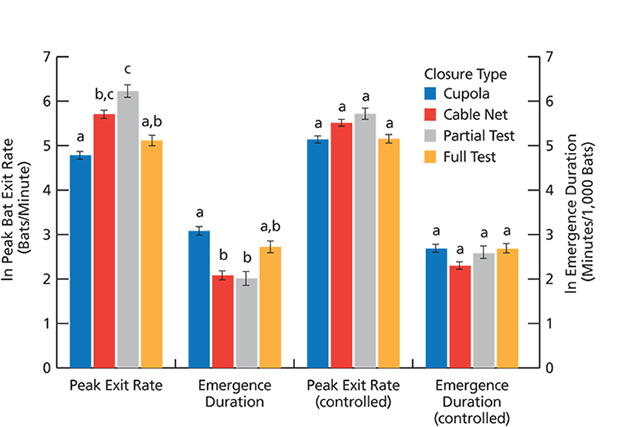
Finding 3: The cupola did not significantly affect the rate at which the bats could exit the roost
After controlling for correlation between bat exit rate and colony size, we found the bat exit rate with the main cupola to be not significantly different from the rate recorded with the cable net (fig. 8). The peak exit rate was lower during dates with the cupola than during dates with the cable net or test gates, but not significantly lower than with these other closure types (all P > 0.31). Additionally, the standardized emergence duration was slower during dates with the cupola than during dates with the cable net or test gates, but not significantly slower than with these other closure types (all P > 0.47). The time taken for 25, 50, 75, and 100 percent of the total number of bats to emerge on a given night did not differ between dates with the cupola and dates with the cable net (all P > 0.29). We could not test for differences between the cupola and test gates because of low sample size.
Conclusion
The State of Texas Mine at Coronado National Memorial continues to serve as a roost for lesser long-nosed bats. National Park Service work has led to protection of this roost from human disturbance. This study documented that the bat-compatible gates installed on the roost openings at the mine do not appear to be causing increased injury or mortality to the bats, or to be impeding the bats’ ability to exit the roost. However, this study does indicate that lesser long-nosed bat colony size has decreased at the State of Texas Mine. This declining trend is likely related to a number of factors, including changing forage availability, a large wildfire on the Coronado National Memorial in 2011, drought, and other potential habitat changes within the range of this species. Further monitoring of this gate is recommended using the methods designed in this study to ensure that the lesser long-nosed bat colony at the State of Texas Mine continues to thrive. This evaluation provides valuable insight into management of this species on National Park Service lands and throughout this bat’s range.
Acknowledgment
In memory of Ronnie Sidner, PhD, 29 September 1950 to 2 August 2014, for her contribution to this study and devotion to bat research, conservation, and education.
References cited
Arizona Emergency Information Network (AZEIN). 2011. Monument Fire 90 percent contained: Crews continue patrol of fire line. Bulletin available at http://www.azein.gov/azein/Lists/Announcements/DispForm.aspx?ID=1882.
Ceballos, G., T. H. Fleming, C. Chavez, and J. Nassar. 1997. Population dynamics of Leptonycteris curasoae (Chiroptera: Phyllostomidae) in Jalisco, Mexico. Journal of Mammalogy 78:1220–1230.
Cockrum, E. L., and Y. Petryszyn. 1991. The long-nosed bat, Leptonycteris: An endangered species in the Southwest? Texas Tech University Museum, Occasional Papers 142:1–32.
Fleming, T. H., A. A. Nelson, and V. M. Dalton. 1998. Roosting behavior of the lesser long-nosed bat, Leptonycteris curasoae. Journal of Mammalogy 79:147–155.
Mindat.org and the Hudson Institute of Mineralogy. 2015. State of Texas Mine, Montezuma Canyon, Hartford District (Huachucha Mountains District), Huachuca Mountains, Cochise County, Arizona, USA. Accessed May 2015 at http://mindat.org.
Rojas-Martinez, A., A. Valiente-Banuet, M. del Coro Arizmendi, A. Alcantara-Eguren, and H. T. Arita. 1999. Seasonal distribution of the long-nosed bat (Leptonycteris curasoae) in North America: Does a generalized migration pattern really exist? Journal of Biogeography 26:1065–1077.
Sidner, R., and Vernadero Group. 2011. 2010 annual monitoring of the endangered lesser long-nosed bat, Fort Huachuca, Arizona. Submitted to Environmental and Natural Resources Division Directorate of Public Works, U.S. Army Garrison, Fort Huachuca, Arizona, USA. March.
Stoner, K. E., A. Karla, O. Salazar, C. Roxana, R. Fernandez, and M. Quezada. 2003. Population dynamics, reproduction, and diet of the lesser long-nosed bat (Leptonycteris curasoae) in Jalisco, Mexico: Implications for conservation. Biodiversity and Conservation 12:357–373.
Tibbitts, T. 2010. Threatened and endangered species: Annual summary of activities. Report. USFWS Permit #TE819458-0. Lesser long-nosed bat (Leptonycteris curasoae). National Park Service, Organ Pipe Cactus National Monument, Arizona, USA. November.
U.S. Fish and Wildlife Service (USFWS). 1988. Endangered and threatened wildlife and plants: Determination of endangered status for two long-nosed bats. Federal Register 53(190):38456–38460. 30 September.
———. 2010. Biological opinion on a proposal to close abandoned mine lands (AMLs) within Coronado National Memorial, Organ Pipe National Monument, Saguaro National Park, and Grand Canyon National Park. AESO/SE 22410-2009-F-0452. 12 April.
Wilkinson, G. S., and T. H. Fleming. 1996. Migration and evolution of lesser long-nosed bats, Leptonycteris curasoae, inferred from mitochondrial DNA. Molecular Ecology 5:329–339.
Wolf, S., and D. Dalton. 2009. Summary of State of Texas Emergence Counts. Data provided by Coronado National Memorial.
———. 2010. Monitoring a Test Gate for Leptonycteris yerbabuenae at the State of Texas Mine, Coronado National Memorial, Arizona, 2009.
About the authors
Amanda Best, a senior environmental specialist with WestLand Resources, Inc., was the project manager of this study and contributed to the study design and implementation. Gabrielle Diamond, an environmental specialist with WestLand Resources, was the lead video analyst and assistant project manager of this study. Joel Diamond with the Arizona Game and Fish Department, Wildlife Contracts Branch, was a contributor to the study. Debbie Buecher and Ronnie Sidner, independent contractors and bat biologists, were contributors to the study design and analysis and conducted the video camcorder survey. David Cerasale, a senior scientist at WestLand Resources, was a primary contributor to the study and performed the study’s statistical analysis. James Tress Jr., president of WestLand Resources, was the main contributor to the study design and implementation. Linda Dansby is the NPS Intermountain Region Energy and Minerals Program coordinator and contracting officer’s representative. Jason Mateljak is chief of Resource Management, National Park Service—Southern Arizona Group. Adam Springer is Integrated Resources Program manager, Coronado National Memorial. Mike Wrigley is a wildlife biologist with the Intermountain Region, National Park Service. Tim Tibbitts is a retired wildlife biologist, Organ Pipe Cactus National Monument.
Documentation
Suggested citation for this article
Best, A., G. Diamond, J. Diamond, D. Buecher, R. Sidner, D. Cerasale, J. Tress Jr., L. Dansby, J. Mateljak, A. Springer, M. Wrigley, and T. Tibbitts. 2015. Survey of an endangered bat roost at Coronado National Memorial, Arizona. Park Science 32(1):49–56.
This article published
Online: 4 September 2015; In print: 14 September 2015
URL
https://www.nps.gov/articles/parkscience32_1_49-56_best_et_al_3821.htm
This page updated
16 September 2015
Site navigation
Tags
- coronado national memorial
- park science journal
- ps v32 n1
- research report
- arizona game and fish department
- bat-compatible gates
- bat emergence rates
- bat migration
- bat roosts
- endangered bats
- endangered species
- huachuca mountains
- leptonycteris yerbabuenae
- lesser long-nosed bats
- state of texas mine
- u.s. fish and wildlife service
- video camcorder survey
- rare & endangered species
- research & studies
- research
- bats
Last updated: March 19, 2021

